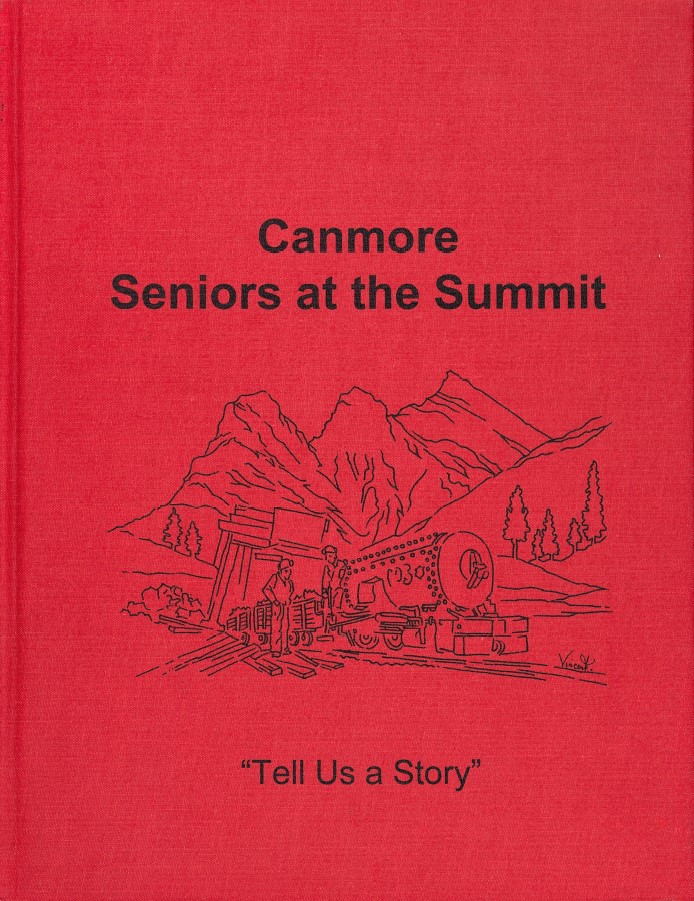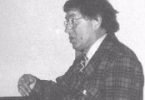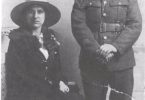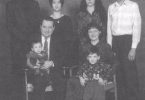My parents and grandparents were pioneers in Banff. “Dad” Barnett, my grandfather, was a street sweeper who used a hand pushcart before cars were allowed in the Park. My father was a railroad fireman who had worked for the Soo Line in the U.S.A. on its inaugural run. My mother came over from England and worked in a girls’ school in Toronto and Winnipeg. She and my dad, Bill Kane, met while both were employed at the Banff Springs Hotel. They were married in a small church down by the river, now the Presbyterian Hall in Banff. My sister, Bessie, and brother, Jack, were born in Banff. My oldest sister walked from the Banff Springs Hotel to school in the old firehall.
When the Banff Springs Hotel burned down, my dad walked from Banff to Drumheller where he got work as a fireman at the Atlas Mine. My two brothers, Bob and Jim, and I were born in Drumheller. One other sister died in the flu epidemic of 1915-16. I went to school for two years in a little one-room school. Saturday night was bath night, then we went downtown and sat and watched people on the street. I recall “Dance Tonight in the Miners Hall — gents-50 cents, ladies free”.
My two brothers and I used to picnic in mine boxcars or on grain doors. When small, our dog ‘Sport’ used to babysit us, not allowing us to wander. Close by were three small hills: Faith, Hope and Charity. Faith was a little too steep for me to climb, but my older brother Jack used to go up there to fly his kite. Charity was all gumbo and when it rained, we had to stay away. But Hope was okay and I used to climb there and sit on a flat rock at the top. There was a small trickle of water from the mine in our backyard and I once caught a lizard and tied it by the tail to a stake there. When I returned, only his tail remained.
I do not recall playing inside. My mother’s favorite words were, “Get your coats on and get outside.” Another favorite saying was, “I can’t, I’ve got a bone in my leg,” when we wanted her to do something. In winter, we cut blocks and built forts from the packed snow. My mother called us in by banging on a frying pan.
There was a mine bone pile in our front yard and we used to go out with our lard pails to pick up coal, so we always had fuel. Because the coal gas bothered my father we left Drumheller in 1928, loaded down with everything we owned, plus us six kids. We had two flat tires on the way to Banff and arrived at 2 a.m. We went to the campground, now the golf course, where I first saw running water, from a tap!! In Drumheller we had had a water barrel and bought our water. I remember being lowered down into the barrel to clean it before more water was delivered. A woman camper was horrified to see me run a basin of water to clean my teeth. She showed me how to do it under running water. All eight of us moved into a two room cabin which had a kitchen and one large room where all six kids slept on the floor on mattresses. The toilet in the corner often flooded, causing panic to get the mattresses up before they got wet!!
My father used to take us down to the station to see the trains come in. He said no good fireman would allow his engine to belt out smoke while in, or leaving, the station.
I started school in Banff in grade three. At first there were only four rooms, then they opened two more rooms upstairs for grades six and seven. At one time there were five Kanes in the school. My sister worked as an usher in the theatre and would sometimes sneak me in if I would help clean up the theatre after the show. I remember when the first talkie came to Banff. A lot of us kids stood outside hoping someone would invite us to go inside. No one did! My two brothers, Bob and Jim, used to roll tires up Tunnel Mountain, a local sport. Sometimes we would pick raspberries. We played around Bow Falls and at Spray River, always being yelled at by the golfers.
Going home, we were always hungry. When we sent my youngest brother up ahead, quite often a kind person would give him five cents. While he looked at candy, the two of us sneaked a cookie from the cookie barrel. The clerks soon caught on to us. We were always hungry. We grew up on bread: bread and sugar; bread and jam; bread and ketchup; bread and gravy. My father liked his meat boiled so there was always lots of gravy. We were allowed to eat four slices of bread and gravy before supper, probably to save on the meat. As we ate six loaves of bread a day, it’s a good thing the price was three loaves for $0.25. I recall having company one time and we had canned pears for dessert. Normally my father would not allow canned vegetables or fruit. Anyway our young visitor was offered bread with hers. She declined. My question, “How come I have to eat two slices of bread with my half pear when she didn’t” caused some trouble for me!
Every Saturday in winter there was free swimming at the Cave and Basin and my two brothers and I always walked up. We skated in Whiskey Creek. As we got older we used to hike down the “Y” of the railroad and build fire and roast potatoes. We never got them really finished because the warden, “spy Peyto” always caught us.
When I was a Girl Guide, we spent some Saturdays hiking up the Spray with the Scouts. The scout leader made a fire and we cooked our lunch. My mother would have given me $0.10 to buy a pork chop.
Most people shopped at Naglers in Calgary because they would ship out. I recall driving to Calgary, leaving our cream bottle at Hollowood Ranch, then picking it up on the way back as well as 50 lb. of butter from the creamery at Cochrane. One time I had to use a bathroom in Calgary. My dad went to a house and offered the lady ten cents if I could use hers.
My mother took in laundry to help support us. It was my job to hang out the clothes and do the mangling, singing as I folded “selvage to selvage and hem along hem.” My mother at first worked at Hart Laundry. My grandmother ran a laundry in England and my mother had learned to iron when she was big enough to reach the ironing board laid across two chairs.
I don’t remember ever having a birthday party, but a friend said she remembers hiding behind the mangle and getting stuck. My mother lifted her out and was not even angry. My friend commented, “what a kind, nice mother you have.”
Harry Elliott came to Banff in 1936 to work in his father’s bakery. He delivered bread and I used to skip my last spare in school to run out to meet him on his rounds. Eventually I worked in the bakery and his dad bought a family season ticket so he and I and his sister and brother-in-law could skate at Mathers Rink. We didn’t have dances in school until grade nine and in our first year Jerry Fuller was the band leader. The boys sat on one side of the room and the girls on the other.
Dad died in 1939. Mum tried to get a widow’s pension, but couldn’t.
I went to work at the Bank of Commerce during the war and still remember the bank manager’s advice, “Even if you don’t know what you are talking about, if you can convince people that you do, they will believe you”. I had to get permission from Head Office to marry Harry. We were married in the United Church in Banff when Harry came home on leave from the Navy. When I opened my suitcase that night, my brother-in-law had taken out my clothes and stuffed in a pillow!
Sharyn, Phil and Marvin were born in the old Brett Hospital in Banff. Phil had ear problems and had to have his tonsils out at the age of four, a very stressful time for him as he would not talk to the nurses. Marvin had eczema and was always sick. At the age of nine months his eyesight was damaged by high fever and only one eye recovered. Sharyn at age four would take it upon herself to go grocery shopping, picking up anything she could carry from the bottom grocery shelves. I had to tell the store not to charge things if she came in alone. She pushed her younger brother uptown in a stroller. A friend bought her an ice cream cone and brought them home. Once I left her in a store in Calgary, playing with toys, but was gone too long, and she wandered outside where a lady found her and took her to the police station. When we went down, there was this little girl in a big chair eating an ice cream. Boy, were we relieved!!
Harry went into construction with Mortimer Brothers and eventually as a carpenter for the Federal Government, one winter working only three days a week. I joined the Legion Auxiliary and was first the treasurer and secretary and later president at two different times. Harry built a garage in Windermere and we spent weekends out there with a boat he built. We tore down our old house in Banff and built a new one. I went to work in tourism, first A.M.A., then Dorothy Boyce’s Accommodation Bureau, then the B.C. Government Information Centre. I rented rooms out as we finished them so we could pay for the building. We built in Canmore taking four years then sold in Banff and moved here in 1976. We built a house at Christine Lake when Harry retired and we spent summer out there. We lived in a trailer while building and had a telephone nailed to a tree. We spent three winters in U.S.A – California, Baja and Arizona. Harry died of cancer in 1986.
I jumped into volunteering in everything. I canvassed; I worked for the church, as treasurer of United Church Women, doing kitchen work, whatever. I worked at the Nordic Centre, for the Olympics and other races. I am involved in the Hospital Auxiliary. Regarding the Senior Centre, I spent ten to twelve years on the board and was president for three years. I have been active in curling and aerobics. I received scroll and pin from the Town of Canmore for volunteer work in 1997.
In Canmore Seniors at the Summit, ed. Canmore Seniors Association, 2000, p. 65-67.








